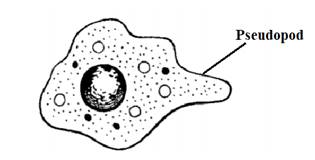
Concept explainers
Introduction :
Members of the phylum Sarcodina are mostly free-living and mound in aquation habitats or damp soil. Nutrition is commonly holozoic. Their body is covered with plasmalemma. They develop a temporary protoplasmic outgrowth known as pseudopod. The pseudopod is the organ for locomotion.
Answer to Problem 6STP
Correct answer :
Option (B) feeding.
Explanation of Solution
Explanation/justification for the correct answer :
Option (B) feeding. Pseudopodia are used for locomotion and engulfing food particles. The receptors are present over the surface of the organism that can detect the food particles in its vicinity. The plasma membrane extends and forms pseudopodia to grab that food particle. It forms a vacuole around it. Digestive juices are poured into the vacuoles containing food particles. The digested food particle is then absorbed by the cytoplasm. The undigested particles are expelled out by running the whole process in reverse order.

Figure 1 A pseudopod formed by a member of the phylum Sarcodina
Explanation for incorrect answer :
Option (A) conjugation. It is a type of sexual reproduction that takes place in bacteria and some
Option (C) protection. During unfavorable conditions, members of the phylum Sarcodina protect themselves by forming cysts. Pseudopodia do not play any role in protection. Hence, it is an incorrect answer.
Option (D) reproduction. The members of the phylum Sarcodina reproduce asexually by binary fission, multiple fission, budding, and spore formation. In all these processes, pseudopod is not involved. Hence, it is an incorrect answer.
Chapter 19 Solutions
Biology Illinois Edition (Glencoe Science)
Additional Science Textbook Solutions
Campbell Essential Biology (6th Edition) - standalone book
Fundamentals of Anatomy & Physiology Plus Mastering A&P with eText - Access Card Package (10th Edition) (New A&P Titles by Ric Martini and Judi Nath)
Becker's World of the Cell (9th Edition)
Biological Science (6th Edition)
Fundamentals of Anatomy & Physiology (11th Edition)
Anatomy & Physiology
 Human Anatomy & Physiology (11th Edition)BiologyISBN:9780134580999Author:Elaine N. Marieb, Katja N. HoehnPublisher:PEARSON
Human Anatomy & Physiology (11th Edition)BiologyISBN:9780134580999Author:Elaine N. Marieb, Katja N. HoehnPublisher:PEARSON Biology 2eBiologyISBN:9781947172517Author:Matthew Douglas, Jung Choi, Mary Ann ClarkPublisher:OpenStax
Biology 2eBiologyISBN:9781947172517Author:Matthew Douglas, Jung Choi, Mary Ann ClarkPublisher:OpenStax Anatomy & PhysiologyBiologyISBN:9781259398629Author:McKinley, Michael P., O'loughlin, Valerie Dean, Bidle, Theresa StouterPublisher:Mcgraw Hill Education,
Anatomy & PhysiologyBiologyISBN:9781259398629Author:McKinley, Michael P., O'loughlin, Valerie Dean, Bidle, Theresa StouterPublisher:Mcgraw Hill Education, Molecular Biology of the Cell (Sixth Edition)BiologyISBN:9780815344322Author:Bruce Alberts, Alexander D. Johnson, Julian Lewis, David Morgan, Martin Raff, Keith Roberts, Peter WalterPublisher:W. W. Norton & Company
Molecular Biology of the Cell (Sixth Edition)BiologyISBN:9780815344322Author:Bruce Alberts, Alexander D. Johnson, Julian Lewis, David Morgan, Martin Raff, Keith Roberts, Peter WalterPublisher:W. W. Norton & Company Laboratory Manual For Human Anatomy & PhysiologyBiologyISBN:9781260159363Author:Martin, Terry R., Prentice-craver, CynthiaPublisher:McGraw-Hill Publishing Co.
Laboratory Manual For Human Anatomy & PhysiologyBiologyISBN:9781260159363Author:Martin, Terry R., Prentice-craver, CynthiaPublisher:McGraw-Hill Publishing Co. Inquiry Into Life (16th Edition)BiologyISBN:9781260231700Author:Sylvia S. Mader, Michael WindelspechtPublisher:McGraw Hill Education
Inquiry Into Life (16th Edition)BiologyISBN:9781260231700Author:Sylvia S. Mader, Michael WindelspechtPublisher:McGraw Hill Education





